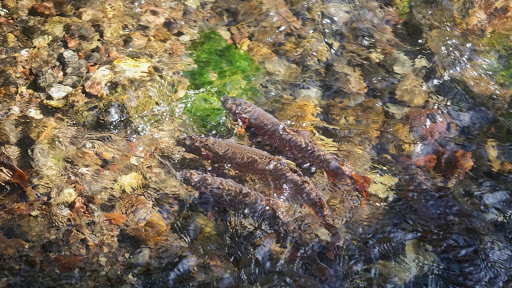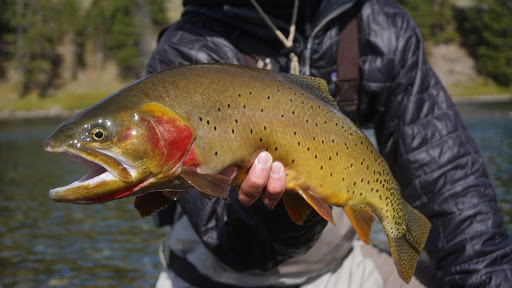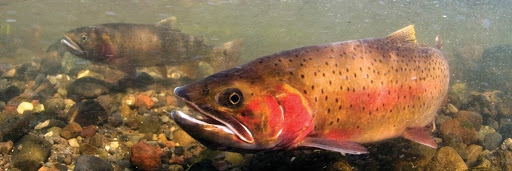Yellowstone Cutthroat Trout and the Fight for Survival


Yellowstone Cutthroat Trout (Oncorhynchus Clarkii Bouvieri)
At a Glance: Yellowstone cutthroat trout (YCT) are a subspecies of trout in the salmonidae family. Cutthroat trout, named for the orange slash on their jaw, will bear large black spots grouped more towards the tail. They are a fluvial fish, meaning that they live and spawn in rivers and streams, but can also be found in lakes given the right conditions. These trout are cold blooded so their body temperature will directly reflect that of their environment. For this reason they can typically be found in waters ranging from 39 to 59 degrees fahrenheit throughout Utah, Idaho, Wyoming and Montana.
History
About 10,000 years ago, as the glaciers that blanketed Yellowstone National Park receded, 12 species of fish dispersed through the region. Some of these fish we still find today in the park such as the yellowstone cutthroat trout, arctic grayling and mountain whitefish. These species settled into inhabitable waters, sometimes finding obstacles such as waterfalls and the continental divide. These landscape features provided a natural variation of species distributed across the landscape and vast areas of fishless water. About 40% of the water in present day Yellowstone National Park was void of fish all together.
In the park’s early years, park management was eager to stock all fishable waters with both native and nonnative fish species to appease visiting anglers. Unaware of the ecological disaster that was to follow, this practice continued from the 1880’s to the mid 1950’s. During this time it is estimated that 300 million fish were stocked throughout Yellowstone National Park. YCT populations were decimated as nonnative fish outcompeted them for habitat and food resources. At this time rainbow trout, a close relative to the cutthroat, were hybridizing which led to a decline in the genetic integrity of the native trout.
Ecological Significance
Yellowstone Lake boasts the largest population of YCT in the country, which serves as a staple in many predator’s diets. Before nonnative species had been introduced to these waters, hundreds of thousands of YCT would move into small rivers and streams in late June to spawn. In 1980 approximately 70,000 YCT were counted as they spawned in Clear Creek alone. When these fish spawn vital biomass is dispersed into the ecosystem feeding more than a dozen bird species, grizzly bears, and otters.
In the 1980’s lake trout were illegally introduced to Yellowstone Lake. Lake trout, which spawn in lakes, decimated the YCT populations leaving spawning streams nearly bare. By 2008 Clear Creek spawning populations were reduced to only 600 fish. When predators that depend on these fish find their numbers diminished, they look elsewhere to supplement their diet. Grizzlies that cannot find the spawning trout may look for more elk calves. Bald eagles may turn their attention to ducklings.

Yellowstone cutthroat trout on the Yellowstone River. Learn Author Kirk Ryder's tips for Flyfishing in Yellowstone Here!
Restoration and Conservation
Yellowstone National Park has implemented a variety of conservation tools across the range of YCT to combat non-native species and enhance the persistence of existing populations. These tools include the use of pesticides (fish toxins), mechanical methods (electro-fishing and gillnetting), erecting barriers to prevent fish migration, and angler catch and kill requirements. These tools are used to protect and preserve the genetic integrity of the native YCT by reducing hybridization and competition between species.
In 1995, park fisheries biologists confirmed that lake trout were successfully reproducing in Yellowstone Lake. While nobody can be sure of how they got there, swift action was taken to suppress their numbers. Gillnets were strung across deep portions of the lake that lake trout would likely inhabit. While the park succeeded in catching lake trout, they were simply not catching enough. Starting in 2009, the park contracted a commercial company to increase the harvest of lake trout. Lake trout harvest is also supplemented by recreational anglers, catching and killing an estimated 20,000 each year. Currently, population models estimate a 70% decline in adult size lake trout.
In 2012 the Elk Creek Complex (Elk, Lost, and Yancey creeks) was treated with rotenone to remove the nonnative brook trout that were stocked in the 1940’s. Rotenone will kill all living things in a river and was used annually from 2012 to 2014. Once the brook trout were both eliminated, the waters were restocked with genetically pure YCT. The waters had been restored to the native species. Natural reproduction has been documented at this time using electrofishing surveys.
In 2013 Soda Butte Creek was modified to entirely eliminate the threat of nonnative fish traveling in the park. This was a necessary course of action for the park because brook trout had become established in Soda Butte Creek outside of the park and were slowly filtering inside of the park. While electrofishing techniques were employed to suppress their numbers, it was not enough to keep these trout from moving downstream into the Lamar River. Eventually, 450 brook trout were removed through chemical treatments and Ice Box canyon was permanently modified to eliminate any chance of nonnative species entering the park.
Outlook
Yellowstone cutthroat trout are a keystone species in the Greater Yellowstone Ecosystem, meaning they have a dispropotionately large role to play. While the park will spend millions in perpetuity to protect them, the ends justify the means. With current technology, we cannot fully eliminate the lake trout, but with continued suppression efforts we will see the YCT thrive. Provided the park maintains its current high levels of suppression effort, biologists estimate that reducing the lake trout population to a level that will have only minor impacts to the YCT population will take until 2025. Park biologists are now also turning their attention to killing lake trout embryos. So far, only 50 acres of lake trout spawning areas have been identified by tagging fish, visual observations during SCUBA sessions, and remote observations with underwater cameras.

Yellowstone cutthroat trout holding in shallow water (NPS/Jay Fleming)
Guide Bio
Kirk, originally from Massachusetts, developed an intense curiosity and interest in the outdoors spending his summers in the Berkshire Mountains. His college years lead him through the Adirondacks to St. Lawrence University where he studied environmental science, government and served as vice president to the Hunting and Fishing Club. During these college summers Now situated in Jackson, Kirk spends his free time backcountry skiing, hiking, fishing and rafting. Kirk’s excitement for outdoor education and sharing it with others is a terrific combination as he seeks to inspire others to better understand the natural world and what it means to be a part of the GYE.












